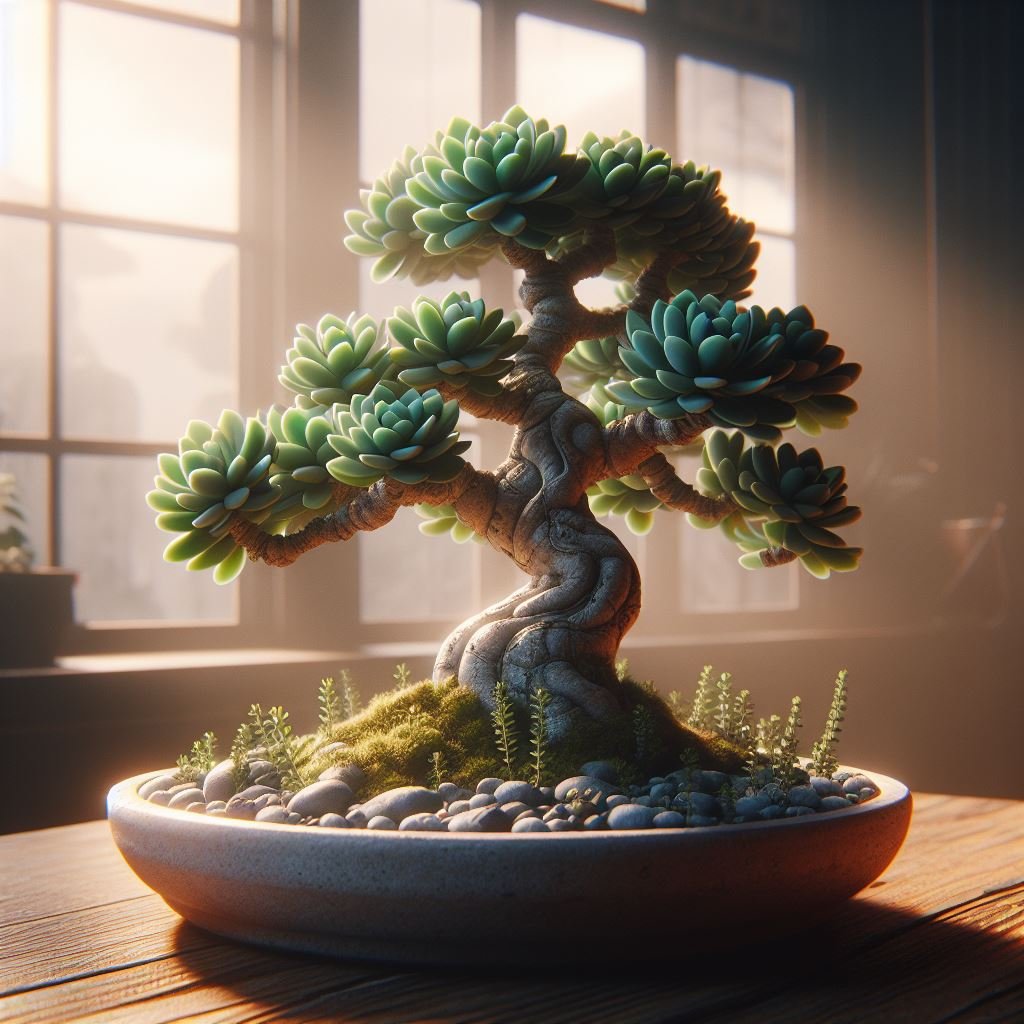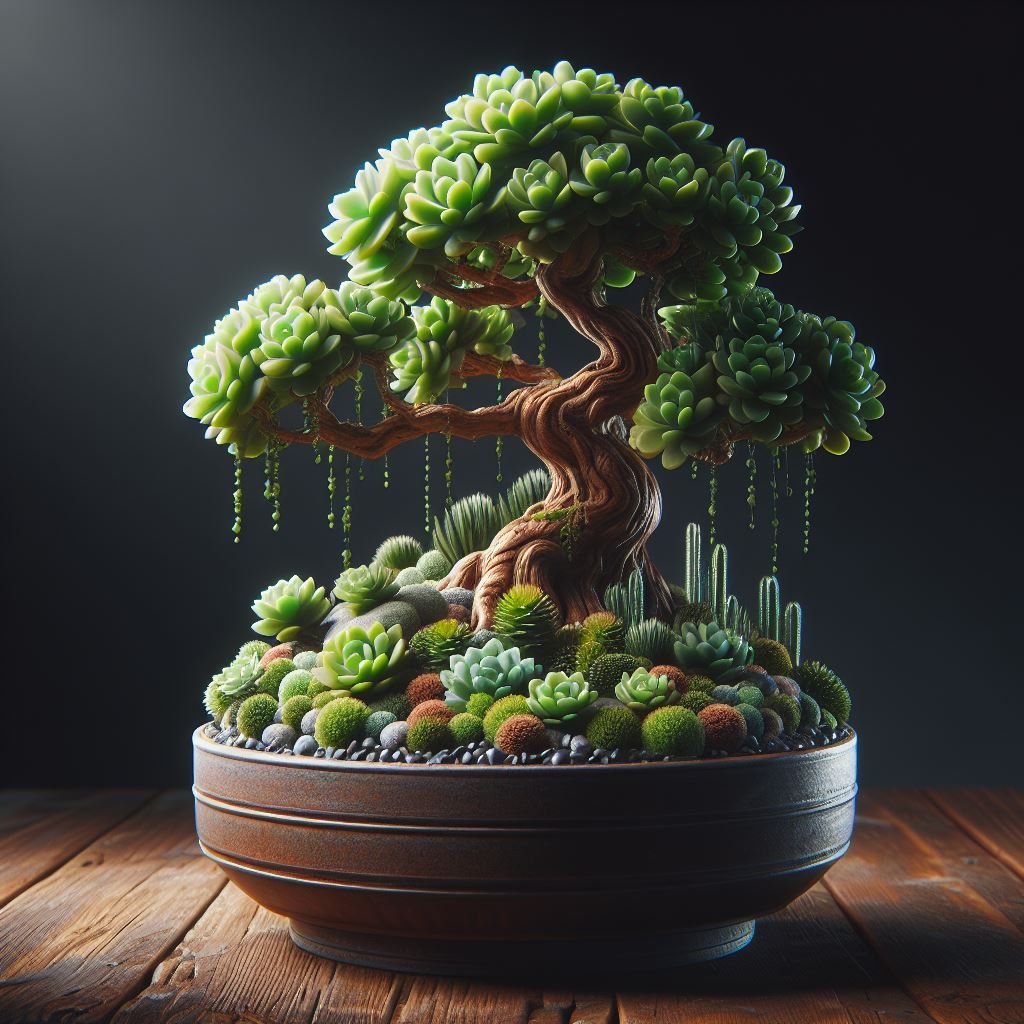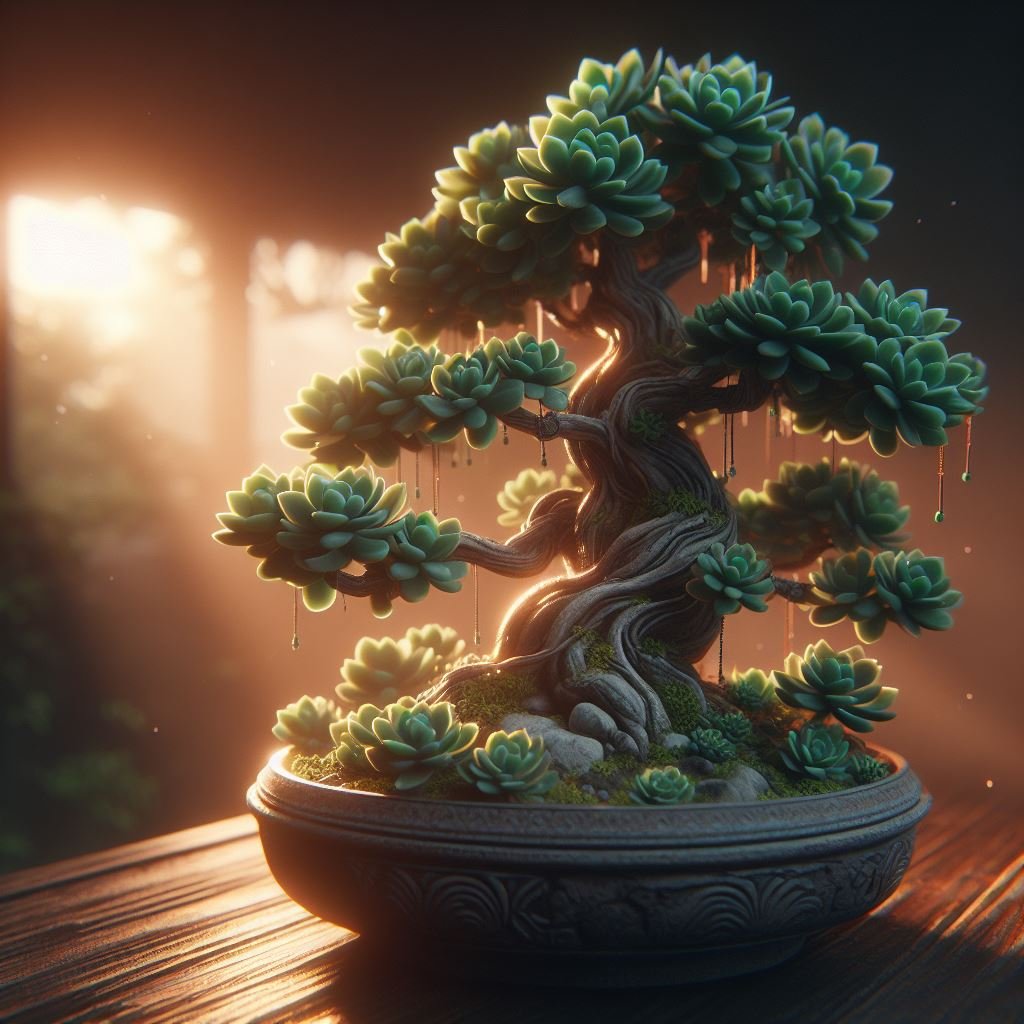The Jade Bonsai, often known as the “Money Tree,” is a popular choice among indoor plant enthusiasts due to its appealing aesthetics and manageable care requirements. This fleshy, softly woody shrub can grow up to 3 meters tall, featuring a thick trunk and fine branch structure adorned with succulent oval green leaves. From choosing the right cutting to understanding the ideal soil conditions, this comprehensive guide will walk you through the process of growing and maintaining a thriving Jade Succulent Bonsai.
Introduction

Brief Overview of the Jade Succulent Bonsai
Jade Succulent Bonsai, also known as the Crassula ovata, is a hardy, evergreen plant that originates from South Africa. It’s admired for its glossy, oval-shaped leaves that have a rich jade color, and for its ability to form a thick, woody trunk that gives it the appearance of a miniature tree. With proper care and training, a Jade Bonsai can become a stunning piece of living art, adding elegance and tranquility to any indoor space.
Its Popularity and Reasons for it
The Jade Succulent Bonsai has gained widespread popularity among both beginners and experienced bonsai enthusiasts. This is largely due to its resilience and adaptability, making it an excellent choice for those who are new to bonsai cultivation. Furthermore, its unique aesthetic appeal, combined with its symbolic representation of prosperity in many cultures, adds to its charm. The plant’s low-maintenance nature, ability to withstand drought, and flexibility in pruning and shaping make it a rewarding and satisfying endeavor for anyone interested in the art of bonsai.
Understanding the Jade Bonsai

Description of the Jade Bonsai
The Jade Bonsai is a succulent plant that displays an array of physical attributes making it a unique piece of horticulture. The most striking feature is its thick, woody trunk that mimics the look of a mature tree, despite its miniature size. The tree usually grows up to 3 meters tall when grown in the wild, but when cultivated as a bonsai, it is kept much smaller. The Jade Bonsai’s oval-shaped leaves are a rich, jade green color, glossy on the surface and often with red edging if exposed to enough sunlight. It also produces small, star-shaped white or pink flowers during the cooler months, adding to its appeal.
The Significance of the Jade Bonsai
The Jade Bonsai is commonly known as the “Money Tree” due to its association with financial luck and prosperity in several cultures. In Feng Shui, it is believed that the Jade Bonsai helps to stimulate the flow of wealth and abundance and should be placed in the southeast corner of your home, the area designated for wealth. Moreover, the plant’s resilience and ability to thrive in a variety of conditions symbolize economic growth and stability. This makes the Jade Bonsai not only a beautiful addition to any space but also a plant with deep cultural and symbolic significance.
Growing a Jade Bonsai

Choosing the Right Cutting
When starting your Jade Bonsai, you’ll need to select a suitable cutting. Look for a healthy branch that is at least 3-4 inches long with a good set of leaves. The cutting should have a sturdy stem that is not too thin or weak. Additionally, try to choose a cutting that has an interesting branch structure, which will add to the visual appeal of your bonsai as it grows and matures.
The Process of Planting and Initial Care
Once you have your cutting, let it dry out for a few days until the cut end forms a callus. This helps to prevent rot when the cutting is planted. Plant the cutting in a mixture of cactus soil and sharp sand (in a 2:1 ratio), which provides excellent drainage. The cutting should be placed about 1 inch deep into the soil.
Water the cutting sparingly until it starts to root, usually within a few weeks. Once roots have formed, you can begin to water more thoroughly. Make sure the soil dries out completely between watering sessions to prevent root rot.
Position your Jade Bonsai in a location where it will receive plenty of indirect sunlight. Too much direct sunlight can scorch the leaves, while too little light can lead to leggy growth and poor health.
Caring for the Jade Bonsai

Ideal Light and Temperature Conditions:
The Jade Bonsai thrives in bright light with some direct sunlight. However, too much direct sun can cause leaf scorch, while too little can lead to weak growth and a loss of vibrant color. A position near a south or west-facing window is often ideal. Regarding temperature, Jade Bonsais prefer warmer conditions and are not frost-tolerant. They do best in temperatures between 65-75 degrees Fahrenheit during the day and should not be exposed to temperatures below 50 degrees Fahrenheit.
Watering Needs and Signs of Overwatering:
Jade Bonsais, like all succulents, have a high drought tolerance and are more likely to suffer from overwatering than underwatering. Water deeply but infrequently, allowing the soil to dry out completely between watering sessions. Overwatering can lead to root rot, a common issue with succulents. Signs of overwatering include yellowing leaves, black stems, and a general look of being unhealthy. If you notice these signs, cut back on watering immediately.
Soil Requirements
The Jade Bonsai prefers a well-draining soil mixture to prevent waterlogging and root rot. A cactus or succulent-specific mix is often a good choice as these are formulated to provide excellent drainage. The soil should ideally be neutral to slightly acidic, with a pH between 6.1 and 6.5. Avoid overly acidic soils as these can harm the plant. Adding some coarse sand or perlite to the mix can improve drainage and provide the slightly gritty texture that Jade Bonsais prefers.
Common Issues and How to Address Them
Leggy Growth – Causes and Solutions
Leggy growth, or etiolation, is a common issue with Jade Bonsai trees and is usually caused by insufficient light. When the plant doesn’t receive enough light, it tends to stretch towards the light source, resulting in longer, thinner stems with more space between leaves. To prevent this, ensure your Jade Bonsai is receiving ample bright, indirect light. If the tree is already exhibiting leggy growth, you may need to prune it back to encourage bushier growth. After pruning, make sure to increase the light it receives.
The Impact of Different Types of Sunlight on Leaf Color
The color of Jade Bonsai leaves can vary depending on the amount of sunlight the plant receives. In low light conditions, the leaves will be a deep, jade green. However, when exposed to more sunlight, the leaf edges can take on a beautiful red hue. This is a normal response to high light levels and not a sign of distress. However, if the leaves turn yellow or brown, it could indicate that the plant is getting too much direct sunlight and is suffering from sunburn. In such cases, move the plant to a location where it will still receive plenty of light but not as much direct sun.
Conclusion
Recap of the Guide’s Key Points
We’ve covered a lot in this guide, from selecting the right cutting for your Jade Bonsai to understanding its care requirements and troubleshooting common issues. The key points to remember are:
- Choose a healthy, sturdy cutting with an interesting branch structure.
- Allow the cutting to callus over before planting in a well-draining soil mix.
- Position your Jade Bonsai in a location with plenty of bright, indirect light and maintain temperatures above 50 degrees Fahrenheit.
- Water sparingly until roots have formed and always let the soil dry out completely between watering sessions.
- Pay attention to the color and growth pattern of your plant’s leaves as they can indicate if the plant is getting too much or too little light.
Encouragement for New Jade Bonsai Growers:
Growing a Jade Bonsai may seem daunting at first, especially if you’re new to bonsai or succulents. However, with patience, regular care, and a little bit of knowledge, you’ll find that these plants are incredibly resilient and rewarding to grow. So don’t be discouraged if you encounter a few hiccups along the way. Every challenge is an opportunity to learn more about your plant and refine your care techniques. Happy growing!
Frequently Asked Questions (FAQs)
How often should I prune my Jade Bonsai?
Pruning is integral for maintaining the shape of your Jade Bonsai and encouraging denser growth. The frequency depends on the growth rate of your plant, but generally, a good prune once or twice a year should suffice.
My Jade Bonsai has lost its vibrant color. What could be the reason?
Loss of color is usually due to insufficient light. Jade Bonsais tend to lose their vibrant green hue and red leaf edges when deprived of enough light. Try adjusting your plant’s location to somewhere with more bright, indirect light.
How do I know if my Jade Bonsai is overwatered?
Signs of overwatering include yellowing leaves, blackening stems, and a generally unhealthy appearance. If these signs are evident, scale back on watering and ensure the soil is completely dry before the next watering session.
Why is my Jade Bonsai dropping leaves?
Leaf drop is usually due to a drastic change in the plant’s environment. This could be a sudden change in temperature, light, or humidity. Remember, Jade Bonsais prefers stability, so avoid making abrupt changes in its surroundings.
Can I grow a Jade Bonsai outdoors?
While Jade Bonsais can be grown outdoors, they thrive best indoors where temperatures and light conditions can be controlled. However, if you live in a region with a climate similar to their native habitat (warm with plenty of indirect sunlight), outdoor cultivation could be successful.
Further Reading and Resources
- Unveiling the Art of Cascade Bonsai: A Comprehensive Guide
- Arbol Bonsai: The Art and Beauty of Miniature Tree Cultivation
- The Allure of Acer Rubrum: Cultivating Red Maple Bonsai Trees
- The Art and Science of Cultivating Vine Maple Bonsai
- The Art and Craft of Growing Loblolly Pine Bonsai: A Comprehensive Guide
- Art of Growing Hydrangea Bonsai: A Complete Guide





